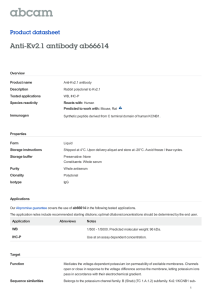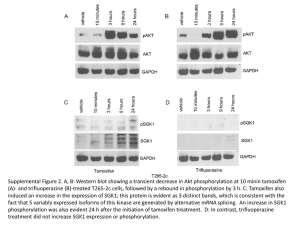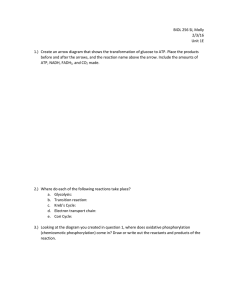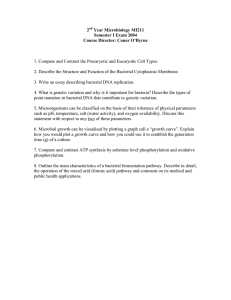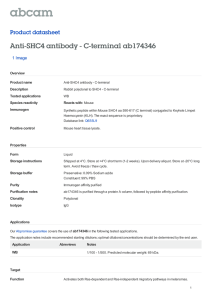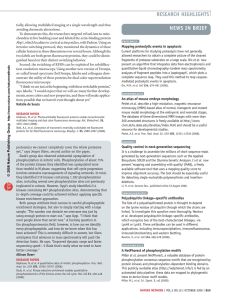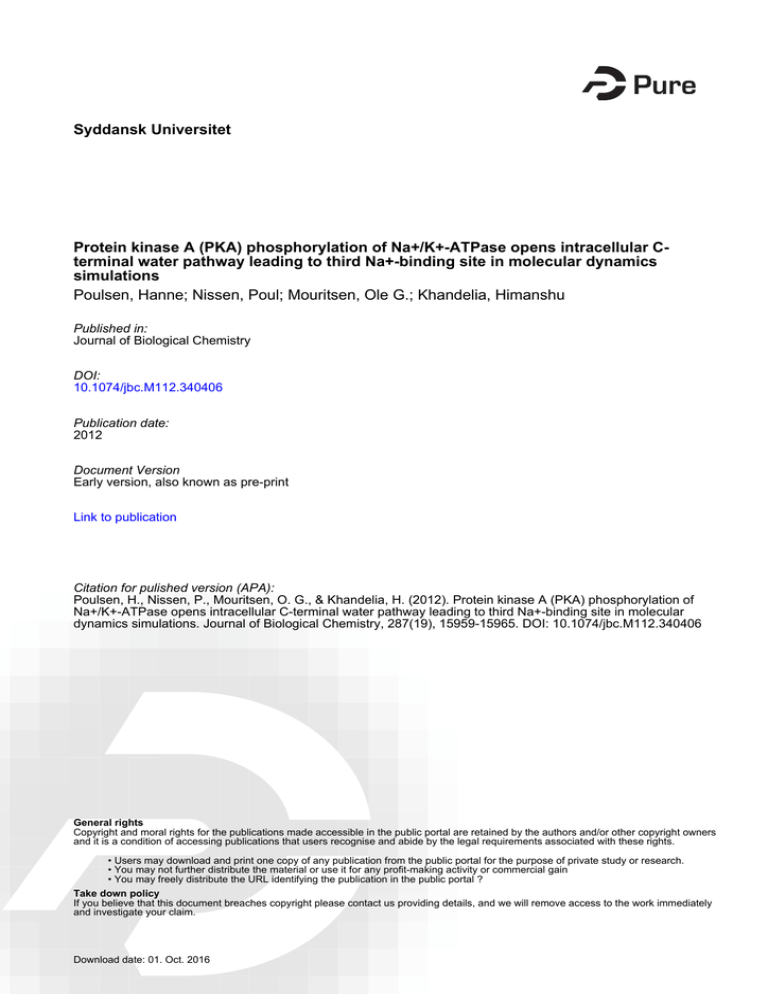
Syddansk Universitet
Protein kinase A (PKA) phosphorylation of Na+/K+-ATPase opens intracellular Cterminal water pathway leading to third Na+-binding site in molecular dynamics
simulations
Poulsen, Hanne; Nissen, Poul; Mouritsen, Ole G.; Khandelia, Himanshu
Published in:
Journal of Biological Chemistry
DOI:
10.1074/jbc.M112.340406
Publication date:
2012
Document Version
Early version, also known as pre-print
Link to publication
Citation for pulished version (APA):
Poulsen, H., Nissen, P., Mouritsen, O. G., & Khandelia, H. (2012). Protein kinase A (PKA) phosphorylation of
Na+/K+-ATPase opens intracellular C-terminal water pathway leading to third Na+-binding site in molecular
dynamics simulations. Journal of Biological Chemistry, 287(19), 15959-15965. DOI: 10.1074/jbc.M112.340406
General rights
Copyright and moral rights for the publications made accessible in the public portal are retained by the authors and/or other copyright owners
and it is a condition of accessing publications that users recognise and abide by the legal requirements associated with these rights.
• Users may download and print one copy of any publication from the public portal for the purpose of private study or research.
• You may not further distribute the material or use it for any profit-making activity or commercial gain
• You may freely distribute the URL identifying the publication in the public portal ?
Take down policy
If you believe that this document breaches copyright please contact us providing details, and we will remove access to the work immediately
and investigate your claim.
Download date: 01. Oct. 2016
JBC Papers in Press. Published on March 20, 2012 as Manuscript M112.340406
Phosphorylation of the sodium pump opens C-terminal ion pathway
The latest version is at http://www.jbc.org/cgi/doi/10.1074/jbc.M112.340406
Protein Kinase A (PKA) Phosphorylation of the Na+/K+-ATPase Opens an Intracellular C-terminal
Water Pathway Leading to the Third Na+-binding site in Molecular Dynamics Simulations
Hanne Poulsen1, Poul Nissen1, Ole G. Mouritsen2 and Himanshu Khandelia2*
From1 PUMPKIN – Centre for Membrane Pumps in Cells and Disease, Aarhus University, Aarhus C,
Denmark
2
MEMPHYS – Center for Biomembrane Physics, University of Southern Denmark, Odense, Denmark.
*Running title: Phosphorylation of the sodium pump opens C-terminal ion pathway
Keywords: Phosphorylation, Sodium Potassium ATPase, Molecular Dynamics, Sodium Pump
Background: There is an ongoing debate on
whether and how the ion pump NKA can be
regulated by a PKA kinase.
Results: Phosphorylation of the PKA target S936
opens an intracellular ion pathway leading to the
ion-binding sites
Conclusion: PKA phosphorylation has a drastic
impact on NAK structure and dynamics
Significance: The molecular mechanism of PKA
regulation of NKA has been described for the first
time.
SUMMARY
Phosphorylation is one of the major
mechanisms
for
posttranscriptional
modification of proteins. The addition of a
compact, negatively charged moiety to a
protein can significantly change its function
and localization by affecting its structure and
interaction network. We have used all-atom
Molecular Dynamics (MD) simulations to
investigate the structural consequences of
phosphorylating the Na+/K+- ATPase (NKA)
residue S936, which is the best characterized
phosphorylation site in NKA, targeted in vivo
by Protein Kinase A (PKA) (1-3). The MD
simulations suggest that S936 phosphorylation
opens a C-terminal hydrated pathway leading
to D926, a transmembrane residue proposed to
form part of the third sodium ion-binding site
(4). Simulations of a S936E mutant form, for
which only subtle effects are observed when
expressed in Xenopus oocytes and studied with
electrophysiology, does not mimic the effects of
S936 phosphorylation. The results establish a
structural association of S936 with the C-
terminus of NKA and indicate that
phosphorylation of S936 can modulate
pumping activity by changing the accessibility
to the ion-binding site.
Ion gradients across cellular membranes sustain
electrical excitability, secondary transport, energy
storage and cell volume regulation. The plasma
membrane contains numerous proteins, e.g. the ion
channels that depend directly on the ion gradients
created by ion pumps. Cation pumps such as the
NKA use the energy of ATP hydrolysis to
transport ions against their concentration gradients
across the membrane. The NKA extrudes three
Na+ ions in exchange of two K+ ions for each
molecule of ATP hydrolyzed.
The NKA α-subunit has the conserved features
of canonical P-type ion-ATPases, including
cytoplasmic nucleotide, phosphorylation and
acutator domains and intramembrane ion-binding
sites. X-ray crystallography has revealed the
structure of NKA in the potassium bound form
(5,6).
In the sodium-bound pump, the two
potassium-binding sites reorganize to achieve high
sodium affinity, but the binding site for the third
sodium ion remains a matter of debate (4,5,7).
PKA phosphorylation is one of several
mechanisms for regulating NKA activity (1-3).
S936 lies near the lipid-water interface, and in
vitro phosphorylation depends on detergent, but
antibodies raised against a peptide with the
phosphorylated S936 show that the site is
phosphorylated in vivo in response to PKA
activiation (reviewed in (8)).
In various cell types, induction of PKA and
phosphorylation of NKA have been found to
1
Copyright 2012 by The American Society for Biochemistry and Molecular Biology, Inc.
Downloaded from www.jbc.org at DEF Consortium - Univ Library of Southern Denmark, on March 22, 2012
To whom correspondence should be addressed: Himanshu Khandelia, MEMPHYS: Center for
Biomembrane Physics, University of Southern Denmark, Odense, Denmark. Phone: +4565503510 Fax:
+4565504048, E-mail: hkhandel@memphys.sdu.dk
Phosphorylation of the sodium pump opens C-terminal ion pathway
EXPERIMENTAL PROCEDURES
Molecular Dynamics Simulations
Simulations were implemented with the pig
renal αβ dimer (PDB accession 3B8E (5))
embedded in a fully hydrated 111 Å x 111 Å x 190
Å
1-palmitoyl-2-oleoyl-sn-glycero-3phosphocholine (POPC) lipid bilayer. POPC is a
lipid well-known model lipid used to model
membranes both in simulations and in experiments
in a large variety of systems, ranging from proteinmembrane interactions such as ion-channel (19)
and ion-pump simulations (4,20-22) to drug
binding assays (23). A POPC membrane is in the
fluid phase at room temperature.
Important
physical properties of the membrane, such as
membrane thickness, area-per-lipid and fluidity,
all of which may impact protein-lipid interactions
are captured accurately by the POPC lipid model.
Finally, lipids diffuse in membranes on time scales
of 100s of nanoseconds. Modeling a mixture of
lipids will therefore bias the simulation towards
their initial placement of lipids in the membrane.
Simulations were performed using GROMACS
version 4.5.3 (24-26) using the modified Berger
force field for lipids (27) and the OPLS-AA all
atom force field for proteins (28). The dihedral
angles of the Berger force field were re-optimized
in order to permit their combination with the
OPLS-AA protein force field (29). The method
reproduced accurate free energy of transfer of
amino acids between aqueous and hydrophobic
lipid phases, and also yielded reasonable proteinlipid interactions for a range of systems, including
transmembrane peptides and proteins such as
OmpF. Furthermore, the Berger force field retains
some of the philosophy of the OPLS united-atom
force field in its treatment of Lennard-Jones
interactions (27). The two publicly available force
fields to run protein-membrane simulations in the
NPT ensemble are CHARMM and the OPLSBerger combination. Simulations run more
efficiently with the latter because it uses united
atoms for lipids. Since the original implementation
of the OPLS-Berger force field combination,
several other important studies have been carried
out using the same force field combination, see for
example (30-32), and reviewed in (33). Therefore,
we use the OPLS-AA protein force field in
combination with the Berger for field for lipids. It
should be noted that depending upon the system of
investigation, different protein force fields may
perform differently, for example, in terms of
predicting the transition states and the folding
rates of proteins (34).
There are no major structural differences in the
C-terminal and ion-binding region of the lowresolution pig renal structure (3B8E) and the
higher resolution shark enzyme (6) (PDB
accession code 2ZXE), other than the presence of
two extra water molecules near the ion binding
sites in the latter. The water molecules appeared
spontaneously in the binding site during our
simulations. All residue numbering follows the
sequence of the pig renal protein. D926 and E954
were kept protonated, as argued earlier (4). All
other aspartate and glutamate residues were
deprotonated, and all arginine and lysine residues
2
Downloaded from www.jbc.org at DEF Consortium - Univ Library of Southern Denmark, on March 22, 2012
correlate inversely with NKA activity, while the
amount of pumps at the plasma membrane
remaining
unaffected,
suggesting
that
phosphorylation of S936 directly lowers pump
activity (3,9-14). Pump trafficking may, however,
also be affected by PKA phosphorylation in some
cell types, apparently via a cAMP independent
pathway responding to the intracellular sodium
levels (15,16).
S936 is only few angstroms from the Cterminus, and we hypothesized that the
phosphorylation may affect the C-terminal
structure. In C-terminal mutants expressed in
Xenopus oocytes, inwardly rectifying leak currents
were observed in the presence of extracellular
sodium (4,17,18) and similar though much smaller
leak currents were observed with the
phosphorylation-mimicking mutation S936E (8).
However,
the
S936E
mutation
might
underestimate the electrostatic and steric effects of
S936 phosphorylation.
Here, the structural effects of S936
phosphorylation are investigated with Molecular
Dynamics (MD) simulations. S936 lies on the
cytoplasmic loop connecting TM8 and TM9,
which is close to the C-terminal interaction
network that controls a pathway to the ion-binding
sites. We examine the effects of S936
phosphorylation on the C-terminal network, on the
ion-binding sites, and on transmembrane structure
and dynamics. Upon phosphorylation, water
molecules enter an intracellular pathway that leads
to the ion binding sites. The pathway is similar to
that described in C-terminal mutants (4). The
finding is significant because it is the first example
of a structural effect of phosphorylation on the
NKA that may explain the marked functional
effects of NKA phosphorylation by PKA.
Phosphorylation of the sodium pump opens C-terminal ion pathway
of nanoseconds. For robust results, each system
was simulated twice, and the results were
reproducible. Furthermore, the simulations are in
good agreement with electrophysiological data,
which indicates that the risk of drawing invalid
conclusions was minimized despite the short
simulation timescales.
Electrophysiology
Pumps were expressed in oocytes from Xenopus
laevis by co-injecting cRNAs encoding ouabain
insensitive hsNKAα2 and hsNKAβ1 (4). After 1–3
days at 19 °C, oocytes were loaded with sodium in
95 mM Na, 90 mM sulfamic acid, 5 mM HEPES,
10 mM TEACl, 0.1 mM EGTA, pH 7.6. Twoelectrode voltage-clamping was performed in 115
mM Na, 110 mM sulfamic acid, 1 mM MgCl2, 0.5
mM CaCl2, 5 mM BaCl2, 10 mM HEPES, 1 µM
ouabain, pH 7.4. To determine pre-steady-state
currents, a series of 200 ms voltage steps was run
with and without 10 mM ouabain, and single
exponentials were fitted to the difference traces to
determine the amount of charges moved (Q) and
the inverse time constants (R).
RESULTS
In oocytes, the mutation of the PKA targeted
serine (number 940 in the human a2 expressed) to
glutamate led to increased leak currents in the
presence of sodium at negative membrane
potentials: an effect reminiscent of the effect of Cterminal mutations, but much milder (4,17). The
C-terminal mutants studied so far furthermore
exhibit severely reduced sodium affinity and
altered kinetics of extracellular sodium binding
and release (4,17,42). These effects are not
observed for the S940E mutant, which has
extracellular sodium affinity and relaxation rate
constants similar to the wild-type values as
determined from pre-steady-state currents after
expression in Xenopus oocytes (Fig. 1). Alpha2
expressing oocytes were treated with forskolin and
IBMX to activate PKA as previously described
(43,44). Phosphorylation was not observed under
these conditions.
The limited effect of the S940E mutation in the
electrical recordings correlates poorly with the
inhibition of NKA observed upon PKA
phosphorylation (9,10). A likely reason for this
discrepancy is that the introduction of glutamate
does not fully replicate the larger steric and
electrostatic effect of explicit phosphorylation, as
previously reported for a cyclin dependent kinase
3
Downloaded from www.jbc.org at DEF Consortium - Univ Library of Southern Denmark, on March 22, 2012
carried a charge of +1. The simulation cell was
kept electrostatically neutral by using Na+ ions.
The simulations were implemented in the
isobaric–isothermal
ensemble.
Temperature
coupling was performed using the Berendsen
thermostat (35) separately for the protein, lipids
and the solvent with a reference temperature of
310 K, and a time constant of 0.1 ps for all
subgroups. A semi-isotropic pressure coupling was
applied using Berendsen barostat (35). A coupling
constant of 1.0 ps and a reference pressure of 1.0
bar was used in all directions. Since the
compressibility, κ, for the systems was not known,
the value for pure water, 4.5·10−5 bar−1 was used.
For the production run, the leap-frog integrator
(36) was used with a time step of 2 fs. All bonds
containing hydrogen were constrained using the
LINCS algorithm (37,38), and water molecules
were constrained with SETTLE (39). Periodic
boundary conditions were applied in all directions.
A neighbor list with a 10 Å cut-off was used for
non-bonded interactions and was updated every 20
fs. The van der Waals interactions were truncated
with a cut-off of 10.0 Å and the electrostatic
interactions were treated with the Particle Mesh
Ewald (PME) (40) method using default
parameters. The center of mass translation was
removed at every step of the simulation.
Trajectories were sampled every 10 ps.
Simulations were run for at least 60 ns. For
calculation of ensemble-averaged properties, the
first 20 ns of the production run of each simulation
were discarded. The analysis was carried out using
GROMACS
or
custom-made
programs.
Visualization and snapshots were rendered using
VMD (41).
The wild-type system was equilibrated using
harmonic constraints on lipids, water and protein.
The constraints were sequentially released,
followed by constraint-free equilibration for 20 ns.
The final conformation from this equilibrated
system was used to start the production runs for
the wild type (WT), the S936E mutant, and the
protein with S936 phosphorylated (S936PHOS).
Two copies of the S936E and S936PHOS
simulations were implemented to collect better
statistics. Most of the results from the two copies
were identical. Simulation snapshots will be
presented only for one copy for brevity. Although
the simulation time scales are indeed short by
current standards, they still successfully capture
the phenomena of interest (opening of water
pathway), which takes place on timescales of 10s
Phosphorylation of the sodium pump opens C-terminal ion pathway
MD simulations of the S936E mutant. In S936E,
the S936E-R1003 interaction and the S936E-E996
repulsion are much weaker compared to
S936PHOS, owing to the lower size and charge (1) of S936E compared to S936PHOS (-2).
Therefore, the movement of the M8-M9 loop
observed in S936PHOS is much smaller with
S936E, and consequently, as observed with the
WT, water does not enter between M5, M7 and
M8.
In the WT and S936E simulations, the Y1016
side chain is bridged to the protonated D926
residue by a single water molecule not observed in
the crystal structures (Fig. 4A). Phosphorylation
increases the distance between Y1016 and D926
significantly (Fig. 5A), and the space between the
two residues is filled by a large number of water
molecules (Fig. 4A). The radial distribution
functions of D926 and water (Fig. 5B) illustrate
that the phosphorylated enzyme has a peak at 1.8
Å and maximal values at 3-5 Å from D926,
indicating substantial hydration, while the WT and
S936E simulations only show peaks at 1.8Å and
3Å as characteristic of a single water molecule
(Fig. 5B)
It is interesting to note that the interactions of
the C-terminal Y1016 residue with K766 and
R933 seen in the crystal structure and in the WT
and S936E simulation also remain largely
unaffected by S936 phosphorylation.
DISCUSSION
MD simulations have been used to investigate
the molecular effects of phosphorylation of S936
in NKA, a well-documented PKA substrate. The
simulations show that in the E2P state,
phosphorylation resulted in movement of the M8M9 loop away from the functionally important Cterminus, causing an altered interaction network of
loops close to the C-terminus that allowed for
water to gain access to a cavity between helices
M5, M7 and M8. Additionally, the simulations
show
that
the
phosphorylation
caused
rearrangements of residues suggested to be
involved in Na+ binding, which may reflect a
weakening of ion binding, so even though S936 is
distant from the ion binding sites, ion-binding is
likely to be affected by PKA phosphorylation.
The opening of the C-terminal pathway in the
simulations upon S936 phosphorylation is similar
to the opening seen with C-terminal mutations.
Disruption of the C-terminal structure was
previously shown to strongly affect both pre-
4
Downloaded from www.jbc.org at DEF Consortium - Univ Library of Southern Denmark, on March 22, 2012
(45). Treatment of oocytes with the adenylyl
cyclase activator forskolin did not alter the pump
characteristics (results not shown). It was
previously reported that NKA phosphorylation in
oocyte homogenates, where PKA was activated by
cAMP, depended on detergent treatment (46),
suggesting that forskolin may be insufficient to
initiate phosphorylation of NKA in the oocytes.
To study the structural effects of explicit
phosphorylation of the PKA site in the sodium
pump, we therefore implemented MD simulations
of the pig renal α1-β dimer in a fully hydrated
POPC membrane, examining WT pump as well as
pumps with the PKA target site S936
phosphorylated.
In the WT protein, the S936 side chain is
hydrogen-bonded to the carboxylate of E996 (Fig.
4A), which is 20 residues upstream of the Cterminus on helix M10. Phosphorylation of S936
breaks the hydrogen bond and electrostatically
repels E996. In the WT, E996 also interacts with
R1003, but phophorylation leads to an electrostatic
salt bridge between S936PHOS and R1003. The
resultant movement of the M8-M9 loop displaces
M8 slightly away from the third sodium-binding
pocket and rearranges the interaction network in
the ion-binding pockets.
Two residues in the ion-binding region, Y771
and N923, are close together in all of the four
available crystal structures of NKA (PDB IDs
3A3Y, 3KDB, 3N23 and 2ZXE). In the MD
simulations of the wild type pump, the side chain
of Y771 even hydrogen bonds with the backbone
of N923 and vice versa (Fig. 2A). The movement
caused by S936 phosphorylation in the MD
simulations breaks the Y771-N923 interaction, and
the Y771 side chain occasionally hydrogen bonds
to the backbone of T807 that is part of the first Na+
binding site.
The reorientation of the transmembrane (TM)
helices in S936PHOS is captured in the changes in
the angle between helices M7 and M8 in Fig. 3.
The radial and axial tilt angles between M7 and
M8 increase, resulting in the opening up of helices
M5, M7 and M8 to a cavity that becomes hydrated
as far as residue D926 (Fig. 4 and Supplementary
movies 1, 2, and 3, coloring scheme same for
movies and Fig. 4). In the WT, no water enters
during the simulations.
To examine if the limited functional effect of
the S936E (S940E) mutation (Fig 1A) correlates
with a limited structural effect of the mutation
compared to the phosphorylation, we performed
Phosphorylation of the sodium pump opens C-terminal ion pathway
the isoforms or even between the different
ATPases. We argue that our finding of PKA
phosphorylation
affecting
the
C-terminal
configuration will be valid for all X,K-ATPases
since they share both the PKA site and the
characteristic C-terminus.
In the WT, the hydrophilic side chains of N923
and Y771 are stabilized by hydrogen bonding to
the backbone atoms of each other. Although N923
and Y771 are proximal in structures, the internal
hydrogen bonding arrangement is not apparent.
Such a scheme of internal mutual hydrogen
bonding could be generally applicable for
stabilizing ion-binding hydrophilic residues in
hydrophobic environments in absence of the
bound ion.
The mutation Y1016F did not alter the sodium
binding affinity of the protein in membrane
extracts (42), while Y1016A reduced the apparent
affinity 5-fold (42), suggesting that the hydroxyl
group is not a primary determinant of sodium
affinity, while the aromatic ring is required. It has
been suggested that R933 and Y1016 interact via a
cation-π bond and not via the Y1016 hydroxyl
group (42,52). However, no configurations from
the MD simulations support a direct cation-π
interaction between R933 and Y1016 or Y1015,
either stacked or “T” interaction, although the
residues are proximal enough in the crystal
structure to facilitate such interactions. Cation-π
interactions in the E1 form or other intermediate
states are also possible explanations to the
importance of an aromatic side chain on the Cterminal residue.
Based on the evidence form MD
simulations presented here, we suggest that PKA
phosphorylation of S936 in NKA affects the
structure of the C-terminus and promotes
hydration of a cavity in the transmembrane region
that connects the cytoplasm and the ion binding
sites. The cavity has been previously identified to
be similarly opened by mutations of residues in the
C-terminal network that severely lower the pump’s
sodium affinity. Our results can thus explain why
PKA activation was reported to inhibit the NKA
pumping activity (3,9-14), and we are currently
pursuing a further structural and functional
understanding of the role of NKA phosphorylation
by PKA.
5
Downloaded from www.jbc.org at DEF Consortium - Univ Library of Southern Denmark, on March 22, 2012
steady state and steady-state currents as measured
with electrophysiology (4,17,18,47). Based on the
leak currents in C-terminal mutants and MD
simulations that showed water entering a Cterminal pathway, an alternative mechanism of
pumping was earlier proposed which involved
proton entry through the C-terminal pathway. The
same pathway opens in the current set of
S936PHOS simulations, suggesting that leak
currents, similar to those in C-terminal mutants
should be observed in the S936E mutant. The
electrophysiological data presented here suggests
that the S936E mutation has little or no effect on
the pump properties; the mutant has affinity for
extracellular sodium similar to the wild type and
only leaks a little more in the precese of
extracellular sodium, which is in contrast to the
significant leak measured with C-terminal mutants
under the same conditions. However, the
electrophysiology data correlate well with the
simulations of the same mutant showing that the
C-terminal pathway does not open in S936E,
unlike what was observed with the phosphorylated
pump. Thus, the S → E mutation is unable to
mimic the effects of a phosphorylation in the
current case. The possible limitations of a
glutamate mutation in mimicking phosphorylation
have been documented earlier, e.g. that glutamate,
unlike phosphorylation, did not act like
phosphothreonine in the activation loop of the
protein cyclin dependent kinase 2 (45).
Of the proposed sodium pump phosphorylation
sites, the PKA site is uniquely conserved – the
consensus PKA recognition sequence, Arg-Arg-XSer/Thr-Φ (where Φ is hydrophobic), is Arg-ArgAsn-Ser-Val/Leu/Ile in all pump isoforms from C.
elegans to man. From different experimental setups, phosphorylation of the PKA site has been
found in either NKAα1 (48), NKAα2 (49) or
NKAα3 (13). PKA phosphorylation even appears
to be conserved in another ATPase, namely the
closely related colonic H,K-ATPase (50). All three
isoforms are phosphorylated by PKA (51). So
while different isoforms are certainly regulated
differently by PKA depending e.g. on their cellular
localization and interaction partners, our studies
address the molecular mechanistic consequences
on ATPase function of the PKA phosphorylation,
and they will not be subject to variation between
Phosphorylation of the sodium pump opens C-terminal ion pathway
REFERENCES
1.
2.
3.
4.
6.
7.
8.
9.
10.
11.
12.
13.
14.
15.
16.
17.
6
Downloaded from www.jbc.org at DEF Consortium - Univ Library of Southern Denmark, on March 22, 2012
5.
Therien, A. G., and Blostein, R. (2000) Mechanisms of sodium pump regulation Am. J. Physiol.
Cell Physiol. 279, C541-C566
Bertorello, A. M., Aperia, A., Walaas, S. I., Nairn, A. C., and Greengard, P. (1991)
Phosphorylation of the Catalytic Subunit of Na+,K+-Atpase Inhibits the Activity of the Enzyme
Proc. Natl. Acad. Sci. U. S. A. 88, 11359-11362
Cheng, X. J., Fisone, G., Aizman, O., Aizman, R., Levenson, R., Greengard, P., and Aperia, A.
(1997) PKA-mediated phosphorylation and inhibition of Na(+)-K(+)-ATPase in response to betaadrenergic hormone Am. J. Physiol. 273, C893-901
Poulsen, H., Khandelia, H., Morth, J. P., Bublitz, M., Mouritsen, O. G., Egebjerg, J., and Nissen,
P. (2010) Neurological disease mutations compromise a C-terminal ion pathway in the Na+/K+ATPase Nature 467, 99-102
Morth, J. P., Pedersen, B. P., Toustrup-Jensen, M. S., Sorensen, T. L., Petersen, J., Andersen, J.
P., Vilsen, B., and Nissen, P. (2007) Crystal structure of the sodium-potassium pump Nature 450,
1043-1049
Shinoda, T., Ogawa, H., Cornelius, F., and Toyoshima, C. (2009) Crystal structure of the sodiumpotassium pump at 2.4 angstrom resolution Nature 459, 446-U167
Morth, J. P., Pedersen, B. P., Buch-Pedersen, M. J., Andersen, J. P., Vilsen, B., Palmgren, M. G.,
and Nissen, P. (2011) A structural overview of the plasma membrane Na+, K+-ATPase and H+ATPase ion pumps Nat. Rev. Mol. Cell Biol. 12, 60-70
Poulsen, H., Morth, P., Egebjerg, J., and Nissen, P. (2010) Phosphorylation of the Na+,K+ATPase and the H+,K+-ATPase FEBS Lett. 584, 2589-2595
Andersson, R. M., Cheng, S. X., and Aperia, A. (1998) Forskolin-induced down-regulation of
Na+,K(+)-ATPase activity is not associated with internalization of the enzyme Acta Physiol.
Scand. 164, 39-46
Venosa, R. A. (2005) Protein kinases A and C stimulate the Na+ active transport in frog skeletal
muscle without an appreciable change in the number of sarcolemmal Na+ pumps Acta Physiol.
Scand. 185, 329-334
Bertorello, A. M., Aperia, A., Walaas, S. I., Nairn, A. C., and Greengard, P. (1991)
Phosphorylation of the catalytic subunit of Na+,K(+)-ATPase inhibits the activity of the enzyme
Proc. Natl. Acad. Sci. U. S. A. 88, 11359-11362
Cheng, S. X., Aizman, O., Nairn, A. C., Greengard, P., and Aperia, A. (1999) [Ca2+]i determines
the effects of protein kinases A and C on activity of rat renal Na+,K+-ATPase J. Physiol. (Lond).
518 ( Pt 1), 37-46
Wu, Z. Q., Chen, J., Chi, Z. Q., and Liu, J. G. (2007) Involvement of dopamine system in
regulation of Na+,K+-ATPase in the striatum upon activation of opioid receptors by morphine
Mol. Pharmacol. 71, 519-530
Oliveira, M. S., Furian, A. F., Rambo, L. M., Ribeiro, L. R., Royes, L. F., Ferreira, J., Calixto, J.
B., Otalora, L. F., Garrido-Sanabria, E. R., and Mello, C. F. (2009) Prostaglandin E2 modulates
Na+,K+-ATPase activity in rat hippocampus: implications for neurological diseases J.
Neurochem. 109, 416-426
Kristensen, B., Birkelund, S., and Jorgensen, P. L. (2003) Trafficking of Na,K-ATPase fused to
enhanced green fluorescent protein is mediated by protein kinase A or C J. Membr. Biol. 191, 2536
Vinciguerra, M., Deschenes, G., Hasler, U., Mordasini, D., Rousselot, M., Doucet, A.,
Vandewalle, A., Martin, P. Y., and Feraille, E. (2003) Intracellular Na+ controls cell surface
expression of Na,K-ATPase via a cAMP-independent PKA pathway in mammalian kidney
collecting duct cells Mol. Biol. Cell 14, 2677-2688
Meier, S., Tavraz, N. N., Durr, K. L., and Friedrich, T. (2010) Hyperpolarization-activated inward
leakage currents caused by deletion or mutation of carboxy-terminal tyrosines of the Na+/K+ATPase alpha subunit J. Gen. Physiol. 135, 115-134
Phosphorylation of the sodium pump opens C-terminal ion pathway
18.
19.
20.
21.
22.
24.
25.
26.
27.
28.
29.
30.
31.
32.
33.
34.
35.
36.
37.
38.
39.
7
Downloaded from www.jbc.org at DEF Consortium - Univ Library of Southern Denmark, on March 22, 2012
23.
Yaragatupalli, S., Olivera, J. F., Gatto, C., and Artigas, P. (2009) Altered Na+ transport after an
intracellular alpha-subunit deletion reveals strict external sequential release of Na+ from the Na/K
pump Proc. Natl. Acad. Sci. U. S. A. 106, 15507-15512
Wang, H. L., Cheng, X., Taylor, P., McCammon, J. A., and Sine, S. M. (2008) Control of cation
permeation through the nicotinic receptor channel PLoS Comp. Biol. 4, e41
Law, R. J., Munson, K., Sachs, G., and Lightstone, F. C. (2008) An ion gating mechanism of
gastric H,K-ATPase based on molecular dynamics simulations Biophys. J. 95, 2739-2749
Espinoza-Fonseca, L. M., and Thomas, D. D. (2011) Atomic-level characterization of the
activation mechanism of SERCA by calcium PLoS One 6, e26936
Musgaard, M., Thogersen, L., and Schiott, B. (2011) Protonation states of important acidic
residues in the central Ca(2+) ion binding sites of the Ca(2+)-ATPase: a molecular modeling
study Biochemistry (Mosc). 50, 11109-11120
Witzke, S., Duelund, L., Pedersen, M., Kongsted, J., Mouritsen, O. G., and Khandelia, H. (2010)
The inclusion of terpenoid plant extracts in lipid bilayers investigated by molecular dynamics
simulations J. Phys. Chem. B 114, 15825–15831
Berendsen, H. J. C., van der Spoel, D., and van Drunen, R. (1995) GROMACS: A messagepassing parallel molecular dynamics implementation Comput. Phys. Commun. 91, 43-56
Hess, B., Kutzner, C., van der Spoel, D., and Lindahl, E. (2008) GROMACS 4: Algorithms for
Highly Efficient, Load-Balanced, and Scalable Molecular Simulation J. Chem. Theoret. Comput.
4, 435-447
Spoel, D. V. D., Lindahl, E., Hess, B., Groenhof, G., Mark, A. E., and Berendsen, H. J. C. (2005)
GROMACS: Fast, flexible, and free J. Comput. Chem. 26, 1701-1718
Berger, O., Edholm, O., and Jähnig, F. (1997) Molecular dynamics simulations of a fluid bilayer
of dipalmitoylphosphatidylcholine at full hydration, constant pressure, and constant temperature
Biophys. J. 72, 2002-2013
Jorgensen, W. L., Maxwell, D. S., and TiradoRives, J. (1996) Development and testing of the
OPLS all-atom force field on conformational energetics and properties of organic liquids J. Am.
Chem. Soc. 118, 11225-11236
Tieleman, D. P., Maccallum, J. L., Ash, W. L., Kandt, C., Xu, Z., and Monticelli, L. (2006)
Membrane protein simulations with a united-atom lipid and all-atom protein model: lipid-protein
interactions, side chain transfer free energies and model proteins J Phys Condens Matter 18,
S1221-1234
Chakrabarti, N., Neale, C., Payandeh, J., Pai, E. F., and Pomes, R. (2010) An iris-like mechanism
of pore dilation in the CorA magnesium transport system Biophys. J. 98, 784-792
Provasi, D., Bortolato, A., and Filizola, M. (2009) Exploring molecular mechanisms of ligand
recognition by opioid receptors with metadynamics Biochemistry (Mosc). 48, 10020-10029
Ramachandran, S., Serohijos, A. W., Xu, L., Meissner, G., and Dokholyan, N. V. (2009) A
structural model of the pore-forming region of the skeletal muscle ryanodine receptor (RyR1)
PLoS Comp. Biol. 5, e1000367
Stansfeld, P. J., and Sansom, M. S. (2011) Molecular simulation approaches to membrane
proteins Structure 19, 1562-1572
Piana, S., Lindorff-Larsen, K., and Shaw, D. E. (2011) How robust are protein folding
simulations with respect to force field parameterization? Biophys. J. 100, L47-49
Berendsen, H. J. C., Postma, J. P. M., Vangunsteren, W. F., Dinola, A., and Haak, J. R. (1984)
Molecular-Dynamics with Coupling to an External Bath J. Chem. Phys. 81, 3684-3690
Leach, A. R. (2001) Molecular modelling: principles and applications 2. ed., Pearson Prentice
Hall, Harlow, England
Hess, B. (2008) P-LINCS: A parallel linear constraint solver for molecular simulation J. Chem.
Theoret. Comput. 4, 116-122
Hess, B., Bekker, H., Berendsen, H. J. C., and Fraaije, J. G. E. M. (1997) LINCS: A linear
constraint solver for molecular simulations J. Comput. Chem. 18, 1463-1472
Miyamoto, S., and Kollman, P. A. (1992) Settle: An Analytical Version of the SHAKE and
RATTLE Algorithm for Rigid Water Models J. Comput. Chem. 13, 952-962
Phosphorylation of the sodium pump opens C-terminal ion pathway
40.
41.
42.
43.
44.
46.
47.
48.
49.
50.
51.
52.
Acknowledgements: MEMPHYS-Center for Biomembrane Physics is supported by the Danish National
Research Foundation. The computations were done at the SDU node of the Danish Center for Scientific
Computing (DCSC). PUMPKIN is a Center of Excellence funded by the Danish National Research
Foundation. HK is funded by a Lundbeck Foundation Young Investigator Grant.
FIGURE LEGENDS
Figure 1: The voltage dependence of transient currents of S943E mutated Na/K-ATPase. (A) The charge
translocation (Q/Qmax) of mutated and wild type pumps determined from the off pulses of a series of 20
mV voltage steps and fitted with Boltzmann curves. (B) Relaxation rate constants of mutated and wild
type pumps.
Figure 2: Simulation snapshots showing hydrogen bonding between N923 on M8 and Y771 on M5 in
(A) WT and (B) PHOS simulation at t=55 ns. The side chain of each residue is hydrogen bonded to the
backbone of the other in the WT. Hydrogen bonds are shown as cyan springs. The hydrogen bond is
broken as a result of M8 movement upon phosphorylation.
8
Downloaded from www.jbc.org at DEF Consortium - Univ Library of Southern Denmark, on March 22, 2012
45.
Darden, T., York, D., and Pedersen, L. (1993) Particle mesh Ewald: An Nlog(N) method for
Ewald sums in large systems J. Chem. Phys. 98, 10089-10092
Humphrey, W., Dalke, A., and Schulten, K. (1996) VMD: Visual molecular dynamics J. Mol.
Graphics 14, 33-38
Toustrup-Jensen, M. S., Holm, R., Einholm, A. P., Schack, V. R., Morth, J. P., Nissen, P.,
Andersen, J. P., and Vilsen, B. (2009) The C Terminus of Na+, K+-ATPase Controls Na+
Affinity on Both Sides of the Membrane through Arg(935) J. Biol. Chem. 284, 18715-18725
Awayda, M. S., Ismailov, II, Berdiev, B. K., Fuller, C. M., and Benos, D. J. (1996) Protein kinase
regulation of a cloned epithelial Na+ channel The Journal of general physiology 108, 49-65
Lee, Y. S., Lee, J. A., Jung, J., Oh, U., and Kaang, B. K. (2000) The cAMP-dependent kinase
pathway does not sensitize the cloned vanilloid receptor type 1 expressed in xenopus oocytes or
Aplysia neurons Neurosci. Lett. 288, 57-60
Groban, E. S., Narayanan, A., and Jacobson, M. P. (2006) Conformational changes in protein
loops and helices induced by post-translational phosphorylation PLoS Comp. Biol. 2, e32
Chibalin, A. V., Vasilets, L. A., Hennekes, H., Pralong, D., and Geering, K. (1992)
Phosphorylation of Na,K-ATPase alpha-subunits in microsomes and in homogenates of Xenopus
oocytes resulting from the stimulation of protein kinase A and protein kinase C J. Biol. Chem.
267, 22378-22384
Tavraz, N. N., Friedrich, T., Duerr, K. L., Koenderink, J. B., Bamberg, E., Freilinger, T., and
Dichgans, M. (2008) Diverse Functional Consequences of Mutations in the Na+/K+-ATPase a2Subunit Causing Familial Hemiplegic Migraine Type 2 J. Biol. Chem. 283, 31097-31106
Feschenko, M. S., and Sweadner, K. J. (1994) Conformation-dependent phosphorylation of Na,KATPase by protein kinase A and protein kinase C The Journal of biological chemistry 269,
30436-30444
Teixeira, V. L., Katz, A. I., Pedemonte, C. H., and Bertorello, A. M. (2003) Isoform-specific
regulation of Na+,K+-ATPase endocytosis and recruitment to the plasma membrane Ann. N. Y.
Acad. Sci. 986, 587-594
Codina, J., Liu, J. F., Bleyer, A. J., Penn, R. B., and DuBose, T. D. (2006) Phosphorylation of S955 at the protein kinase A consensus promotes maturation of the alpha subunit of the colonic
H+,K+-ATPase J. Am. Soc. Nephrol. 17, 1833-1840
Blanco, G., and Mercer, R. W. (1998) Isozymes of the Na-K-ATPase: heterogeneity in structure,
diversity in function The American journal of physiology 275, F633-650
Morth, J. P., Poulsen, H., Toustrup-Jensen, M. S., Schack, V. R., Egebjerg, J., Andersen, J. P.,
Vilsen, B., and Nissen, P. (2009) The structure of the Na+,K+-ATPase and mapping of isoform
differences and disease-related mutations Philos. T. R. Soc. B 364, 217-227
Phosphorylation of the sodium pump opens C-terminal ion pathway
Figure 3: The relative axial and radial tilt angles between helices M7 and M8. The dashed lines
correspond to the values in the starting pdb structure. The axial tilt simply represents the angle between
the axes of the two helices. The radial tilt is the angle between the axis of M7 with the projection of the
M7 axis on the plane through the M8 vector and the midpoint of the M7 axis. The two vectors describe
the relative orientation of helices in the helix bundle. The magnitudes of both the radial and axial tilt
angles increase in the PHOS simulations.
Figure 5: Radial distribution functions of (A) Y1016 and (B) water around D926. The function calculates
the local density of one group around the other in concentric spheres around the first group. It is thus a
histogram made over the distance data between two groups over all trajectory frames. A 5-point running
average is shown. The D-Y distance increases significantly in the PHOS mutations, and the resulting
“gap” is filled with water molecules, which are manifest in the higher secondary peaks in (B), showing
greater hydration of D926.
9
Downloaded from www.jbc.org at DEF Consortium - Univ Library of Southern Denmark, on March 22, 2012
Figure 4: Simulations snapshots showing the entry of water between helices M5, M7 and M8 for the (A)
WT and (B) PHOS simulation at 55 ns. Water molecules within 8 Å of D926 and within the M5-M7-M8
cavity are shown as purple spheres. K+ ions are shown as small red spheres. Y and D refer to residues
Y1016 and D926. Helices M5, M7, M8 and M10 are shown in transparent green, black, black and blue
respectively. The loop connecting M8 and M9, and the last 13 C-terminal residues are shown as orange
ribbons. A larger number of water molecules populate the cavity between M5, M7 and M8 in the PHOS
simulation. Please refer to Supplementary movies S1, S2 and S3 for dynamics of entry of water
molecules.
Phosphorylation of the sodium pump opens C-terminal ion pathway
FIGURES
Figure 1
Downloaded from www.jbc.org at DEF Consortium - Univ Library of Southern Denmark, on March 22, 2012
10
Phosphorylation of the sodium pump opens C-terminal ion pathway
Figure 2
Downloaded from www.jbc.org at DEF Consortium - Univ Library of Southern Denmark, on March 22, 2012
11
Phosphorylation of the sodium pump opens C-terminal ion pathway
Figure 3
Downloaded from www.jbc.org at DEF Consortium - Univ Library of Southern Denmark, on March 22, 2012
12
Phosphorylation of the sodium pump opens C-terminal ion pathway
Figure 4
Downloaded from www.jbc.org at DEF Consortium - Univ Library of Southern Denmark, on March 22, 2012
13
Phosphorylation of the sodium pump opens C-terminal ion pathway
Figure 5
Downloaded from www.jbc.org at DEF Consortium - Univ Library of Southern Denmark, on March 22, 2012
14

